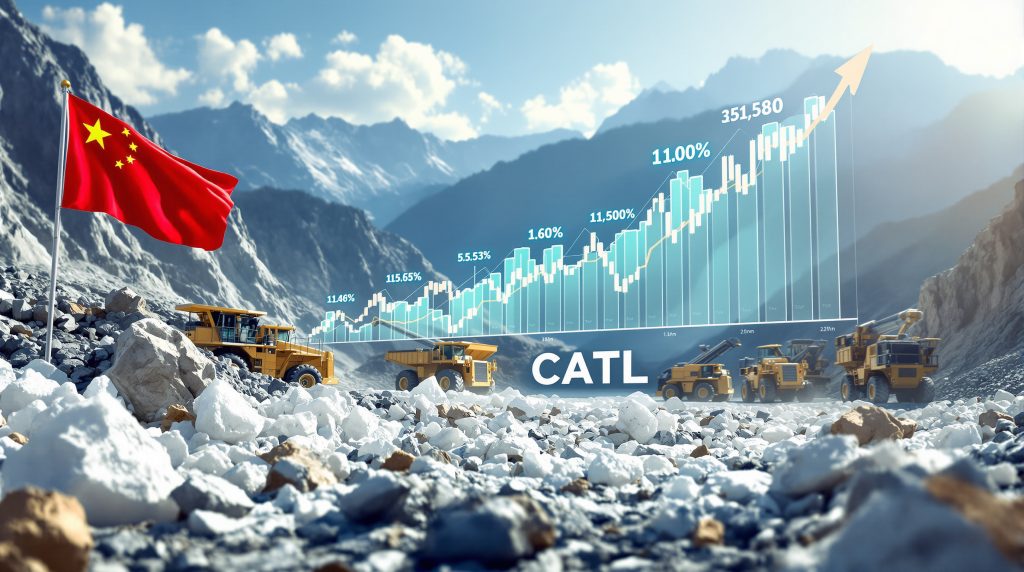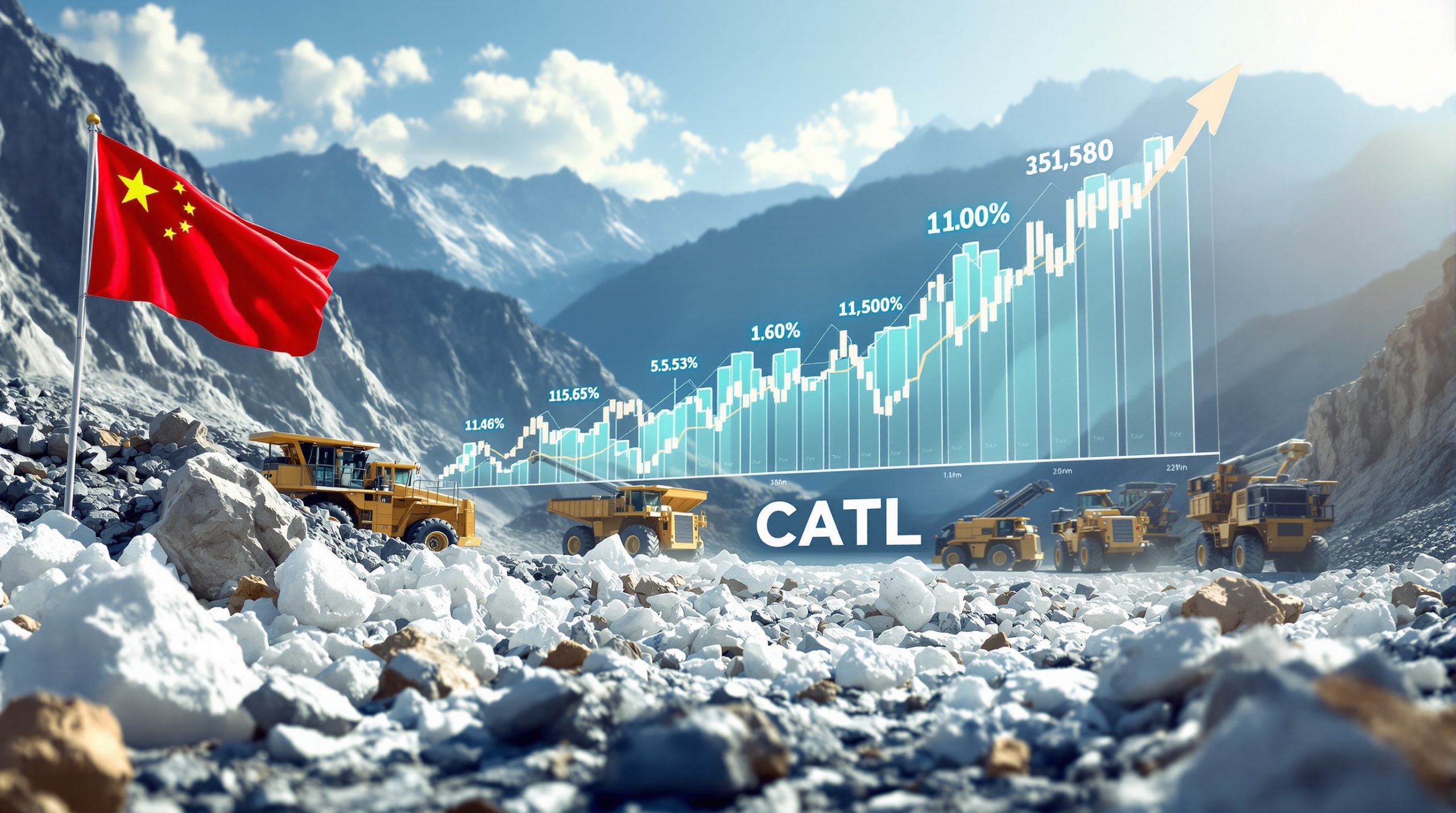China Approves CATL Mine Reserves: Key Implications for Global Lithium Markets
China's recent approval of reserve reports for CATL's Jianxiawo lithium mine represents a pivotal moment for the global lithium supply chain. This regulatory green light from Chinese authorities has eased industry concerns about potential supply disruptions, particularly at a time when the sector's overcapacity issues have attracted increased government scrutiny. The development comes as lithium markets navigate through a period of price volatility, driven largely by uncertainties surrounding production capabilities in the critical mining hub of Yichun.
The approval marks an important step toward operational resumption for CATL, the world's largest EV battery manufacturer, whose mining activities at Jianxiawo had been suspended since August 2025. While this development doesn't guarantee an immediate restart, it signals progress in addressing the administrative hurdles that led to the initial suspension.
The Strategic Significance of China's Regulatory Move
The regulatory approval process offers insight into China's evolving approach to critical mineral resource management. By implementing more structured oversight of lithium production, Chinese authorities appear to be balancing development needs with strategic resource conservation. This measured approach may help stabilize the volatile lithium market while ensuring that China maintains its dominant position in the global battery supply chain.
Industry analysts note that these regulatory developments reflect China's long-term vision for its battery materials sector, prioritizing sustainable growth over unfettered expansion. The approval process demonstrates how China is increasingly focused on orderly market development rather than allowing boom-bust cycles that could undermine its strategic advantages in electrification technologies.
What Led to the Regulatory Review of Yichun's Lithium Operations?
The comprehensive review of Yichun's lithium operations stemmed from an administrative audit that uncovered significant operational shortcomings across the mining hub. Following these findings, Chinese authorities mandated that eight producers in the region submit detailed reserve reports by September 30, 2025, as part of a broader compliance initiative.
Administrative Challenges and Compliance Requirements
The regulatory intervention in Yichun reveals the increasing sophistication of China's mining oversight mechanisms. The issues identified weren't limited to simple administrative oversights but reflected more fundamental concerns about resource quantification, extraction methodologies, and environmental management practices.
For CATL specifically, the suspended operations at Jianxiawo resulted from an expired mining permit—a technical compliance issue with far-reaching market implications given the company's prominence in the global battery supply chain. The fact that such a major player encountered permit renewal difficulties highlights the stringent nature of China's evolving regulatory framework.
Environmental Considerations in the Regulatory Framework
Environmental compliance has emerged as a central element of China's mining regulation strategy. The approval of ecological restoration plans for Gotion High-Tech demonstrates how environmental sustainability has become inseparable from operational authorization. This environmental focus represents a significant evolution in China's approach to resource extraction, moving from primarily production-focused policies toward more balanced frameworks that consider ecological impacts.
The enhanced scrutiny aligns with China's broader environmental goals, including carbon reduction targets and ecological restoration priorities. For mining operations in sensitive areas like Yichun, these environmental requirements now constitute non-negotiable elements of the regulatory approval process.
What Does This Approval Mean for CATL's Mining Operations?
For CATL, the reserve approval represents a critical milestone in the path toward operational resumption at Jianxiawo. While this approval doesn't automatically reinstate the expired mining permit, it removes a significant obstacle in the regulatory process. According to industry sources, CATL management has begun preparing staff for a potential operational restart, though no specific timeline has been confirmed.
The Pathway to Full Operational Resumption
The reserve approval process involves verifying the quantity and quality of lithium resources at the site, confirming that extraction plans align with national resource management objectives. For CATL to fully resume operations, additional regulatory steps may still be required, potentially including:
- Final mining permit renewal
- Approval of updated extraction methodologies
- Verification of environmental compliance measures
- Confirmation of resource conservation plans
These steps reflect China's methodical approach to resource management, ensuring that mining operations align with both economic and sustainability objectives.
Market Implications of CATL's Operational Status
As the world's largest EV battery manufacturer, CATL's production capabilities have outsized influence on global supply chains. The suspension at Jianxiawo created uncertainty in lithium markets, with pricing volatility reflecting concerns about potential supply constraints. The reserve approval has partially alleviated these concerns, though the market continues to monitor for signals about when full production might resume.
The operational disruption at Jianxiawo offers valuable insight into the interconnectedness of modern battery supply chains. Even temporary interruptions at major production hubs can trigger ripple effects throughout global markets, affecting everything from raw material pricing to investment decisions in downstream manufacturing capacity.
Which Other Companies Received Regulatory Approvals?
Gotion High-Tech's Comprehensive Regulatory Success
In contrast to CATL's operational interruption, Gotion High-Tech successfully maintained continuous production throughout the regulatory review period. The company secured multiple regulatory approvals that strengthen its operational position:
| Approval Type | Status | Significance |
|---|---|---|
| Reserve Report | Approved | Validates resource estimates and extraction plans |
| Mining Design | Approved | Authorizes specific extraction methodologies |
| Ecological Restoration Plans | Approved | Confirms environmental compliance |
| Production Authorization | Granted | Permits discretionary production based on business needs |
This comprehensive suite of approvals gives Gotion High-Tech significant operational flexibility and market advantage during a period of regulatory uncertainty. The company's success in navigating the regulatory process while maintaining production continuity highlights the importance of proactive regulatory compliance in China's evolving mineral resource landscape.
Competitive Positioning Among Yichun Producers
Gotion's ability to secure these approvals while continuing production stands in stark contrast to CATL's operational suspension. This divergence in regulatory outcomes creates at least a temporary competitive advantage for Gotion in the lithium market, allowing it to potentially capture market share during CATL's operational disruption.
The different regulatory outcomes for these major producers may reflect variations in their compliance approaches, relationship management strategies with regulatory authorities, or fundamental differences in their operational practices. Understanding these distinctions provides valuable insight for other producers operating in China's increasingly regulated mining environment.
How Has the Lithium Market Responded to These Developments?
The lithium market has demonstrated significant sensitivity to developments at Yichun, with price movements closely tracking announcements about operational status and regulatory approvals. When CATL initially announced the suspension of operations at Jianxiawo in August 2025, market concerns about potential supply constraints pushed prices upward. Conversely, news in early September that CATL was preparing for a potential restart triggered downward price movements, reflecting the market's rapid recalibration to changing supply expectations.
Price Volatility Patterns Through the Regulatory Process
This price volatility underscores how centralized China approves catl mine reserves decisions have become, with regulatory decisions in a single mining hub capable of influencing global market sentiment. The correlation between operational announcements and price movements reveals the market's ongoing challenges in accurately forecasting supply-demand balances, particularly during periods of regulatory uncertainty.
The market response also demonstrates the growing sophistication of lithium pricing mechanisms, with greater segmentation between different product qualities and specifications. This evolving market structure allows for more nuanced pricing signals that better reflect specific supply-demand imbalances within different segments of the lithium value chain.
Supply Chain Adaptation Strategies
Battery manufacturers and EV producers have implemented various strategies to navigate the supply uncertainty created by the Yichun regulatory review:
- Inventory management adjustments: Companies have revised optimal inventory levels to provide greater buffer against short-term supply disruptions
- Supplier diversification initiatives: Accelerated efforts to qualify alternative suppliers from different regions
- Contract structure modifications: New pricing mechanisms that provide greater flexibility during supply disruptions
- Technical adaptations: Exploring chemistry modifications that reduce dependency on specific lithium compounds
These adaptations reflect the maturing battery supply chain's increasing resilience to localized disruptions, though significant vulnerabilities remain in this rapidly evolving market.
Why Is Yichun Important to Global Lithium Supply?
Yichun has emerged as a strategically significant lithium production center with far-reaching implications for global supply chains. Located in China's Jiangxi province, this mining hub hosts substantial lepidolite deposits—lithium-bearing minerals that have become increasingly important in China's domestic lithium production landscape.
The Strategic Significance of Yichun's Lithium Resources
What makes Yichun particularly significant is not just the volume of lithium resources, but its position within China's broader industrial strategy. The region's output feeds directly into China's dominant battery manufacturing sector, creating a vertically integrated supply chain that enhances the country's competitive advantages in electrification technologies.
Yichun's importance has grown as China seeks to reduce dependency on imported lithium, particularly from countries like Australia and Argentina. By developing domestic resources like those in Yichun, China strengthens its supply chain security while maintaining greater control over critical material availability and pricing.
Geopolitical Dimensions of Lithium Resource Management
China's careful management of lithium resources in Yichun reflects broader strategic considerations beyond simple market dynamics. The enhanced regulatory oversight demonstrates how China views these resources as strategic assets rather than purely commercial commodities. This perspective influences everything from permit approval processes to production volume management.
The international implications of Yichun's production decisions ripple through global EV and energy storage markets, affecting investment decisions, technology development pathways, and even national industrial policies in other regions. This interconnectedness highlights how localized regulatory decisions in China's lithium sector now have truly global ramifications.
What Challenges Remain for Lithium Producers in China?
Despite the recent approvals, lithium producers in China continue to face substantial regulatory and market challenges. The approval process for CATL and Gotion High-Tech demonstrates that even the largest, most sophisticated companies must navigate complex administrative requirements to maintain operational continuity.
Ongoing Regulatory Compliance Hurdles
Chinese lithium producers must contend with:
- Evolving permit requirements: Regulations continue to develop, creating compliance uncertainties
- Environmental standard escalation: Increasingly stringent ecological protection standards
- Resource conservation mandates: Requirements to optimize extraction efficiency and minimize waste
- Production volume management: Potential introduction of output limitations to prevent market oversupply
These compliance challenges create operational complexity while potentially limiting production growth, even for producers with approved reserves and permits. The regulatory framework appears designed to ensure orderly market development rather than maximizing short-term production volumes.
Market Balancing Considerations
Beyond regulatory hurdles, Chinese lithium producers face complex market dynamics:
- Overcapacity concerns: Government scrutiny aims to prevent excessive production expansion
- Price volatility management: Balancing production levels to maintain price stability
- Demand uncertainty: EV market growth trajectories directly impact lithium consumption patterns
- International competition: Producers in Australia, South America, and emerging African sources affect market positioning
Navigating these challenges requires sophisticated market intelligence and operational flexibility, capabilities that favor larger, more established producers like CATL and Gotion High-Tech over smaller market participants.
How Might These Developments Affect the Global EV Supply Chain?
The stabilization of Chinese lithium supply through these regulatory approvals has significant implications for the broader EV supply chain. Battery manufacturers benefit from more predictable material availability, enabling better production planning and cost management. This improved visibility supports manufacturing capacity expansion decisions, particularly for facilities targeting the rapidly growing Chinese EV market.
Battery Manufacturing Implications
For battery producers, the regulatory clarity provides several advantages:
- Production scheduling improvements: More reliable material availability supports manufacturing efficiency
- Cost structure stabilization: Supply predictability reduces procurement risk premiums
- Technology development confidence: Resource security enables continued innovation investment
- Capacity expansion certainty: Clearer supply outlook supports manufacturing growth decisions
These benefits extend beyond Chinese manufacturers to international companies with production facilities in China, enhancing the global battery industry's development trajectory.
EV Manufacturing Considerations
Automotive manufacturers gain several strategic benefits from more stable lithium supply:
- Product planning confidence: Reduced material uncertainty supports model development timelines
- Pricing strategy refinement: More predictable input costs improve pricing accuracy
- Supply agreement optimization: Manufacturers can negotiate more favorable long-term supply arrangements
- Regional production balancing: Vehicle assembly location decisions can incorporate more reliable battery supply projections
These advantages help accelerate the broader electrification transition by reducing supply chain uncertainties that have periodically constrained EV production scaling efforts.
What Does This Mean for Global Lithium Market Balance?
The approval of major Chinese lithium reserves has significant implications for global market projections through 2025-2026. By reducing uncertainty about Chinese domestic production capabilities, these approvals help clarify the global supply-demand picture, enabling more accurate forecasting and investment planning.
Supply-Demand Dynamics Through 2025-2026
The regulatory developments influence several key market dynamics:
- Production visibility improvements: Analysts can now incorporate more reliable Chinese output projections
- Market balance recalibration: Extreme supply shortage scenarios become less probable
- Investment confidence enhancement: Capital allocation decisions benefit from reduced uncertainty
- Price volatility moderation: Clearer supply outlook may reduce speculative market movements
While challenges remain in accurately forecasting both supply growth and demand acceleration, the regulatory clarity from China removes a significant source of market uncertainty.
Competitive Landscape Evolution
The regulatory developments accelerate several important industry transformation trends:
- Compliance-driven consolidation: Smaller producers lacking resources for regulatory navigation face increasing challenges
- Major player advantages: Companies with successfully approved reserves strengthen their market positions
- Vertical integration acceleration: Battery manufacturers increasingly secure upstream resources
- International producer repositioning: Non-Chinese suppliers reassess competitive strategies given China's evolving production landscape
These trends suggest an industry moving toward greater consolidation, with advantages accruing to larger, more sophisticated producers with strong regulatory compliance capabilities.
FAQ: China's Lithium Industry Regulation
What triggered the regulatory review of lithium mines in Yichun?
The review originated from an administrative audit that identified compliance shortcomings in mining operations throughout the Yichun region. These findings prompted authorities to implement a structured process requiring reserve verification and permit renewal to ensure proper resource management and environmental protection.
How significant is CATL's Jianxiawo mine to global lithium supply?
While precise production figures aren't publicly disclosed, industry analysts consider the Jianxiawo mine a significant contributor to China's domestic lithium production. Its importance stems not only from its output volume but also from its strategic role in supporting CATL's vertically integrated battery manufacturing operations.
Will these approvals lead to lower lithium prices?
The approvals reduce uncertainty about potential supply disruptions, which may moderate extreme price volatility. However, long-term pricing will continue to depend on broader supply-demand fundamentals, including EV adoption rates, battery technology evolution, and production capacity development across multiple regions.
Are other lithium mining regions in China facing similar regulatory scrutiny?
Yes, Chinese authorities are implementing more comprehensive oversight of critical mineral resources nationwide. The Yichun experience likely represents a model for how similar reviews will be conducted in other mining regions, with emphasis on reserve verification, environmental compliance, and proper administrative documentation.
How does this development affect international lithium producers?
International producers now face a more predictable competitive landscape regarding Chinese domestic supply. This clarity helps inform international investment decisions, production expansion plans, and market development strategies. However, the stronger regulatory framework in China may ultimately strengthen the competitive position of major Chinese producers who successfully navigate these requirements.
Understanding China's Evolving Lithium Strategy
China's approach to lithium resource management reflects its broader strategic objectives in the energy transition landscape. By implementing more structured oversight of domestic lithium production, Chinese authorities balance several priorities:
- Ensuring sustainable supply for China's dominant battery manufacturing sector
- Preventing destructive boom-bust cycles that could undermine industry development
- Strengthening environmental protection in resource extraction regions
- Maintaining China's competitive advantages in electrification technologies
The regulatory developments in Yichun demonstrate how China is refining its governance approach to critical minerals, moving from primarily production-focused policies toward more sophisticated frameworks that balance multiple objectives. This evolution has significant implications for global market participants who must adapt to China's increasingly structured approach to resource management, including those exploring innovative direct lithium extraction methods and geothermal lithium extraction technologies.
Ready to Discover the Next Major Mining Opportunity?
Stay ahead of the market with real-time alerts on significant ASX mineral discoveries through Discovery Alert's proprietary Discovery IQ model, transforming complex data into actionable insights. Explore how historic discoveries have generated substantial returns by visiting Discovery Alert's dedicated discoveries page and begin your 30-day free trial today.




